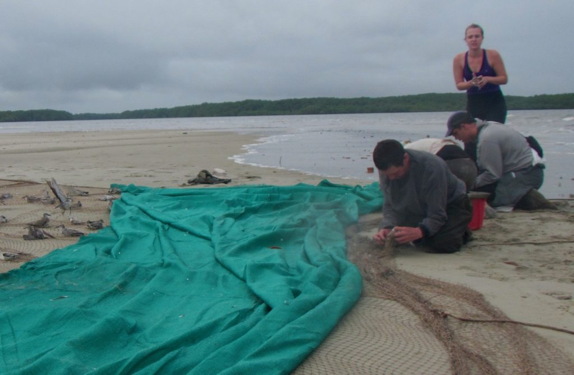Shorebird Expedition Brazil: Trapping shorebirds in Panaquatira
By Larry Niles, LJ Niles Associates LLC
The capture of Arctic nesting shorebirds first brought us to Brazil in 2013. We brought 125 geolocators and caught both ruddy turnstones and red knots, attaching 85 on the former and 30 on the latter. But we also came to create a new perspective on shorebirds in this place, one of the most important shorebird habitats in the world.
For all intents and purposes, shorebird work in this area started in the mid 1980’s, when Canadian biologists, Guy Morrison and Ken Ross surveyed from an airplane, the entire coast of South America. In this monumental and dangerous survey they established an invaluable historic baseline of the number of Arctic nesting shorebirds wintering in South America. This was before shorebirds caught the interest of the public, and way before foundations and agencies devoted significant funding or staff time. They surveyed the entire continent, but on the coast of Maranhao and Para they found the motherlode of shorebirds. They did not, however, get close and personal.

That challenge belonged to a team led by the late Allan Baker of the Royal Ontario Museum and Ines Serrano, then with CEMAVE, the Brazilian counterpart of USGS. They also flew the coast but followed up with a ground survey and the capture of a small group of red knots. Along with Guy and Ken, their work cemented the hemispheric importance of this area.

Over the last 4 years we captured knots, turnstones, sanderlings, whimbrels, collared plovers, semi-palmated sandpipers, semi-palmated plovers as well as South American terns and other species. Last year we recaptured 20 geolocators in a catch of over a hundred ruddy turnstones. But only in 2013 were we able to catch red knots. Although abundant in the region, populations are estimated at 10 to 15K, they are remote and elusive.
So we were happy to find on our first day of surveillance this year over 400 red knots. They roosted within a flock of about 1000 shorebirds located at the west end of a small working class beach resort called Panaquatira, about an hour out of Sao Luis. The flock including black bellied plovers, semi-palmated sandpipers and plovers, collared plovers, South American terns, Black Skimmers and a few whimbrels. We readied that night for an early morning attempt.
First we needed to figure out the tide. It rises and falls 13 feet in northern Brazil, twice that in Delaware Bay. The spring tide or full and new moon tide increases the range to 18 feet. Consequently, the high tide line moves every day and catching birds with a cannon net depends on placing the net near the predicted tide line, because birds move with it to stay as far from the dangers lurking on dry land. Wind speed and direction changes the high tide line, and so does barometric pressure.
So much rides on where we place the net. On our first two attempts, we missed by just a few yards, but it could have been a mile. The birds moved with the tide and stood just outside the 30 by 100-foot area within which the birds must be to be caught. We tried moving them but they spooked and most gradually left the area altogether. Ultimately, we fired but caught only two knots and two whimbrels.
We were blessed on the third day. We arrived near dawn, over four hours before high tide so we had plenty of time to measure elevations. We knew the morning’s high would be about four inches lower than the previous night’s high, which snaked along the sandy peninsula used by the birds to roost. Standing on the tide line we used a method borrowed from Clive Minton to determine the location on the beach four inches lower.
Laying my head flat on the sand I trained my eye towards the horizon. This establishes a level line. Using her hand, Stephanie marks four inches on her leg than moves until the four inch mark lines up with the level line. Her location depends on the slope of the beach. In this way we determined the location of the tide line four hours hence. We dug in the net.

At about an hour before high tide, shorebirds started crowding into the area around the net. At first, oystercatchers, black bellies, short-billed dowitchers and a small flock of skimmers. Most of the knots hung back on an adjacent sand bar. With a little push, they too piled in right into the catch area.
We fired and caught 175 knots, 30 sanderlings, 20 short-billed dowitchers and 5 black-bellied plovers. Among the knots were 3 with geolocators. We flagged, banded and measured 145 birds, all the while releasing unprocessed birds that appeared stressed by the heat. By late afternoon we were back at the house cracking open beers. We completed all our objectives with one day to spare.







Dr. Larry Niles has led efforts to protect red knots and horseshoe crabs for over 30 years.






